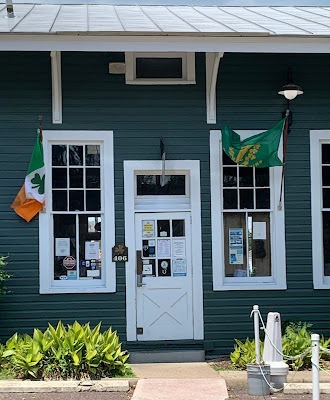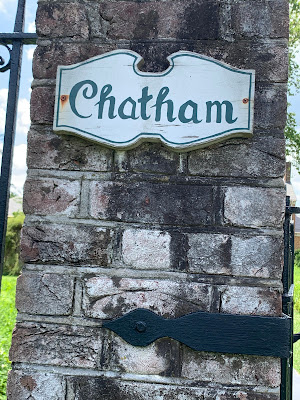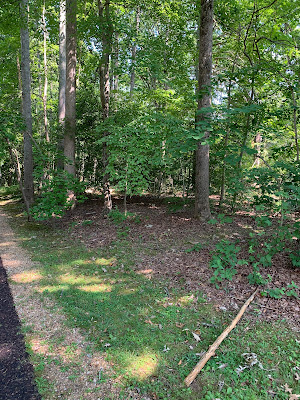During our time at the battlefield, we learned that the Confederate soldiers that were strategically placed behind the stone wall along the sunken road were able to administer an overwhelming victory against their Union adversaries. The Union Army casualties numbered 12,653 opposed to Confederate casualties of 4,201. The Union Commander, General Burnside, was heavily criticized for this crushing defeat in the Fredericksburg battle.
After a recommendation by the Park Ranger for an interesting place for lunch, we moved on down the road to historic town of Fredericksburg.
We then moved on to another site the Park Ranger had recommended - Chatham.
Enslaved laborers and craftsmen built Chatham Manor in 1771 at the direction of William Fitzhugh. The location atop Stafford Heights and its visibility from Fredericksburg put the Fitzhugh's wealth and status on display for everyone. The picture below depicts the viewpoint of Fredericksburg from the backyard of Chatham. The Rappahannock River is between Chatham and downtown Fredericksburg and was one of the obstacles that General Burnside had to overcome before attacking Fredericksburg and, eventually, Mayre's Heights.
The Fitzhughs were related to and good friends with well-known Virginians like George Washington, Thomas Jefferson, and George Mason, the author of the Virginia Declaration of Rights.
At the time of the Civil War, Confederate supporters Betty and J. Horace Lacy owned the home. They lived there in the winter and in the summer lived in their other home, Ellwood in Spotsylvania County. At the outbreak of the war, J. Horace Lacy volunteered to serve in the Confederate Army. Meanwhile, Betty packed up the household and left Chatham empty. This allowed it to be occupied by the Union Army and used as a headquarters during the Battle of Fredericksburg. After the battle, the rooms were transformed into a field hospital. Clara Barton and Walt Whitman served in the hospital, caring for sick and wounded soldiers.
Time to move on to other battlefields in the area.
Despite the heavy casualties sustained there, the Battle of Chancellorsville (April 30 - May 6, 1863) is considered General Robert E. Lee's greatest victory. It was the last battle for Confederate Lt. General Thomas "Stonewall" Jackson who was mortally wounded by friendly fire.
As Lt. General Jackson was riding back to his lines after a late night reconnaissance of the Union positions, his own soldiers mistook his party for Yankee cavalry and fired at them. Two bullets struck Jackson's left arm and shattered it beyond repair. It was amputated at the field hospital at Wilderness Tavern the following day. Normally severed limbs were cremated but Reverend Lacy (Horace Lacy's brother) of Jackson's corps. buried the arm in the Lacy family cemetery at Ellwood. This was the same Lacy family connected with Chatham.
This is the approximate area where he was shot. More on Stonewall Jackson in a future post.
The Battle of Spotsylvania Courthouse was the second major engagement in General Ulysses S. Grant's Overland Campaign, a major Union offensive to chase down Robert E. Lee, destroy his forces, and defeat the Confederacy. The battle was fought May 8-21, 1864. There were 18,000 Union and 12,000 Confederate casualties. Union troops tried repeatedly but failed to break the Confederate line. General Grant ultimately disengaged from the fight and ordered his men to continue their march south.
Along a 200 yard stretch of the Confederate line was called the Bloody Angle of the Mule Shoe where soldiers struggled in the longest hand-to-hand fight of the war. On May 12, Union and Confederate soldiers struggled over this ground for more than 20 hours, through pouring rain, producing unparalleled examples of both courage and carnage.
The earthworks and trenches still exist.
So much history here and so little time.
















Sorry I didn’t tell you to swing by Kenmore. You would have seen a major restoration project by Virginia DAR chapters many years ago. Our chapter has a gavel made from the wood taken from Kenmore.
ReplyDeleteWe'll do it on the next trip!
Delete